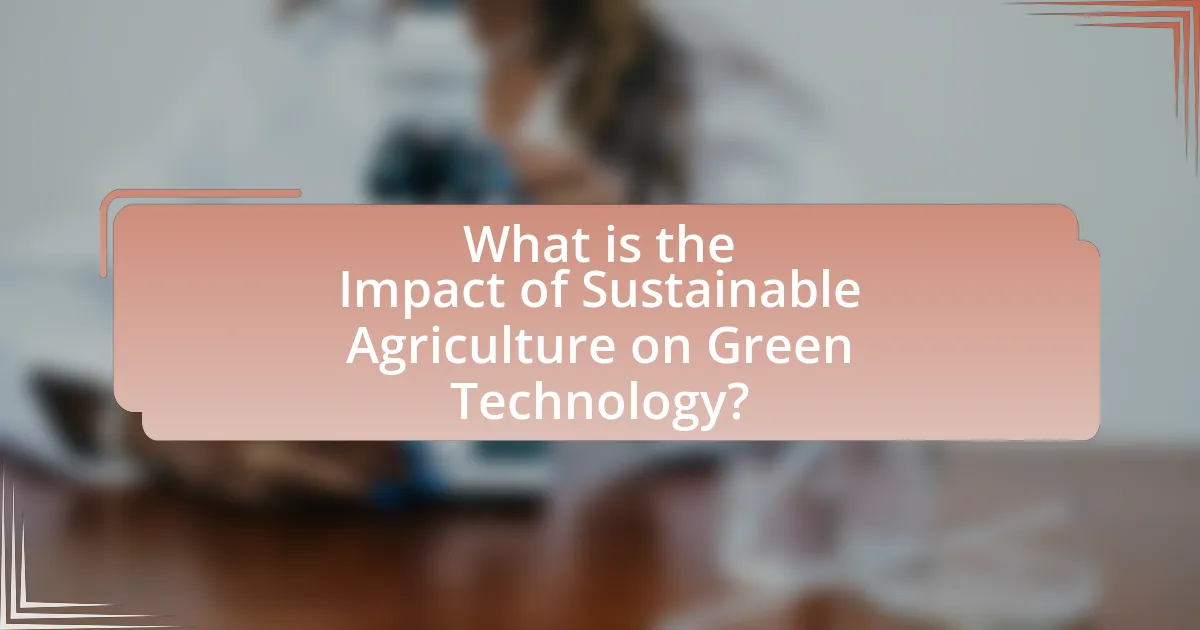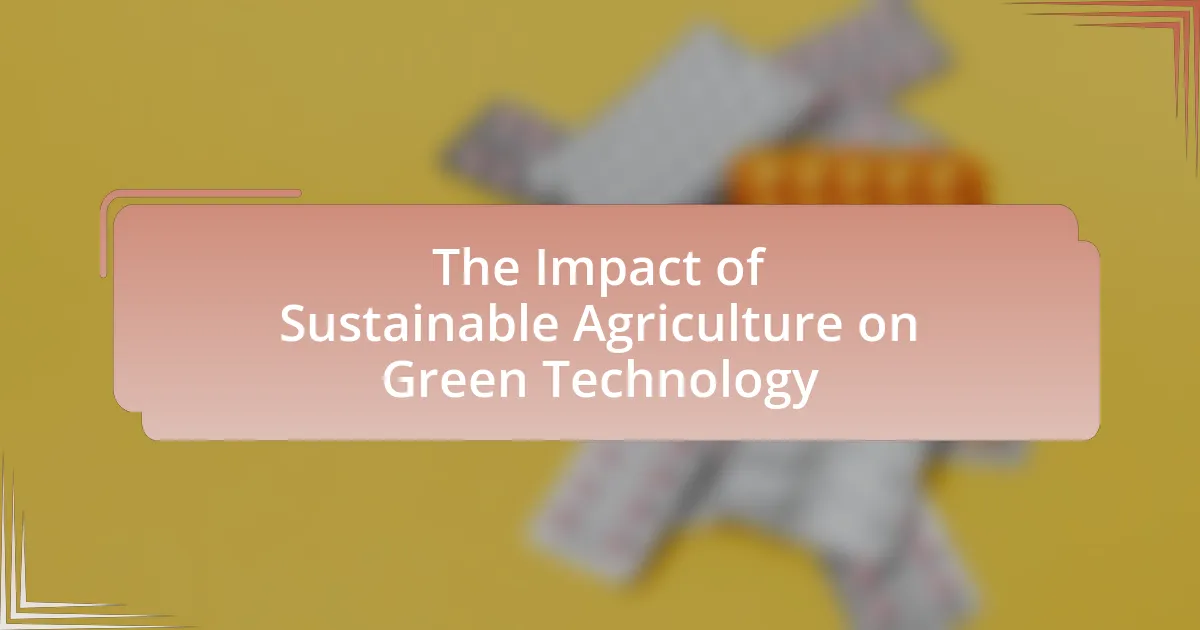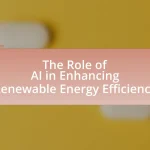The article examines the impact of sustainable agriculture on green technology, highlighting how sustainable practices enhance resource efficiency and reduce environmental impact. It discusses key principles such as crop rotation, organic farming, and the integration of renewable energy sources, which collectively drive innovation in agricultural technology. The relationship between sustainable agriculture and green technology is shown to improve food production efficiency, lower greenhouse gas emissions, and promote economic sustainability. Additionally, the article addresses challenges in aligning these fields, including economic constraints and technological barriers, while outlining future trends and practical steps for farmers to adopt green technologies.

What is the Impact of Sustainable Agriculture on Green Technology?
Sustainable agriculture significantly enhances green technology by promoting practices that reduce environmental impact and increase resource efficiency. This agricultural approach emphasizes methods such as crop rotation, organic farming, and agroforestry, which contribute to soil health and biodiversity. For instance, a study published in the journal “Nature Sustainability” found that sustainable farming practices can reduce greenhouse gas emissions by up to 30% compared to conventional methods. Additionally, sustainable agriculture often incorporates renewable energy sources, such as solar and wind, to power farming operations, further aligning with green technology principles. This integration not only supports environmental sustainability but also fosters innovation in agricultural technology, leading to more efficient water usage and reduced reliance on chemical fertilizers.
How does sustainable agriculture influence green technology development?
Sustainable agriculture drives green technology development by promoting practices that enhance resource efficiency and reduce environmental impact. This approach encourages innovations such as precision farming, which utilizes data analytics and IoT devices to optimize inputs like water and fertilizers, thereby minimizing waste. For instance, a study by the Food and Agriculture Organization (FAO) highlights that sustainable practices can lead to a 20-30% increase in crop yields while reducing greenhouse gas emissions by up to 50%. Additionally, the demand for renewable energy sources in agricultural operations, such as solar-powered irrigation systems, further stimulates advancements in green technologies. These developments not only support agricultural productivity but also contribute to broader environmental sustainability goals.
What are the key principles of sustainable agriculture that affect technology?
The key principles of sustainable agriculture that affect technology include resource efficiency, biodiversity, and soil health. Resource efficiency emphasizes the use of technology to optimize inputs like water and fertilizers, reducing waste and environmental impact. Biodiversity encourages the development of technologies that support diverse cropping systems, enhancing resilience against pests and diseases. Soil health focuses on technologies that improve soil quality and fertility, such as precision agriculture tools that monitor soil conditions. These principles guide the innovation and implementation of green technologies, ensuring they align with sustainable practices and contribute to long-term agricultural viability.
How do sustainable practices drive innovation in green technology?
Sustainable practices drive innovation in green technology by creating a demand for efficient resource use and environmentally friendly solutions. This demand encourages the development of technologies that minimize waste, reduce carbon footprints, and enhance energy efficiency. For instance, the adoption of precision agriculture techniques, which utilize data analytics and IoT devices, has led to innovations in crop management that optimize inputs like water and fertilizers, thereby reducing environmental impact. According to a report by the Food and Agriculture Organization, sustainable agricultural practices can increase productivity by up to 20% while conserving resources, demonstrating a clear link between sustainability and technological advancement in agriculture.
Why is the relationship between sustainable agriculture and green technology important?
The relationship between sustainable agriculture and green technology is important because it enhances food production efficiency while minimizing environmental impact. Sustainable agriculture practices, such as crop rotation and organic farming, benefit from green technologies like precision agriculture and renewable energy systems, which optimize resource use and reduce waste. For instance, the use of drones and sensors in precision agriculture can lead to a 10-20% increase in crop yields while decreasing water usage by up to 30%, demonstrating the effectiveness of integrating these approaches. This synergy not only supports food security but also contributes to the reduction of greenhouse gas emissions, aligning agricultural practices with global sustainability goals.
What environmental benefits arise from integrating sustainable agriculture with green technology?
Integrating sustainable agriculture with green technology leads to significant environmental benefits, including reduced greenhouse gas emissions and improved soil health. Sustainable agriculture practices, such as crop rotation and organic farming, combined with green technologies like precision irrigation and renewable energy sources, enhance resource efficiency. For instance, a study published in the journal “Agricultural Systems” found that precision agriculture can reduce fertilizer use by up to 30%, minimizing nutrient runoff into waterways and decreasing pollution. Additionally, the use of renewable energy in farming operations can lower carbon footprints, contributing to climate change mitigation. These practices not only promote biodiversity but also enhance ecosystem resilience, demonstrating the positive environmental impact of this integration.
How does this relationship contribute to economic sustainability?
The relationship between sustainable agriculture and green technology contributes to economic sustainability by enhancing resource efficiency and reducing costs. Sustainable agriculture practices, such as crop rotation and organic farming, minimize the use of chemical inputs and promote biodiversity, which leads to healthier ecosystems. Green technology, including precision farming tools and renewable energy sources, optimizes resource use, reduces waste, and lowers operational costs. For instance, a study by the Food and Agriculture Organization found that implementing precision agriculture can increase crop yields by up to 20% while reducing water usage by 30%. This synergy not only boosts productivity but also ensures long-term viability of agricultural systems, thereby supporting economic sustainability.
What challenges exist in aligning sustainable agriculture with green technology?
Aligning sustainable agriculture with green technology faces several challenges, primarily including economic constraints, technological accessibility, and regulatory hurdles. Economic constraints arise as farmers often lack the financial resources to invest in advanced green technologies, which can be costly upfront despite long-term savings. Technological accessibility is another significant challenge, as many smallholder farmers may not have access to the latest innovations or the necessary training to implement them effectively. Regulatory hurdles can also impede progress, as existing agricultural policies may not support the integration of green technologies, leading to a lack of incentives for farmers to adopt sustainable practices. These challenges collectively hinder the effective alignment of sustainable agriculture with green technology, limiting the potential benefits for both the environment and agricultural productivity.
What are the technological barriers faced by sustainable agriculture?
Sustainable agriculture faces several technological barriers, including limited access to advanced agricultural technologies, inadequate infrastructure for implementing sustainable practices, and insufficient data analytics capabilities. Limited access to technologies such as precision farming tools and biotechnology restricts farmers from optimizing resource use and improving crop yields. Inadequate infrastructure, including poor irrigation systems and lack of renewable energy sources, hampers the adoption of sustainable practices. Furthermore, insufficient data analytics capabilities prevent farmers from effectively analyzing soil health, weather patterns, and crop performance, which are crucial for making informed decisions. These barriers collectively hinder the transition to more sustainable agricultural systems.
How do policy and regulatory frameworks impact this relationship?
Policy and regulatory frameworks significantly influence the relationship between sustainable agriculture and green technology by establishing guidelines that promote environmentally friendly practices. These frameworks can incentivize the adoption of green technologies through subsidies, tax breaks, or grants, which encourage farmers to implement sustainable practices that reduce environmental impact. For example, the European Union’s Common Agricultural Policy includes measures that support sustainable farming techniques, leading to increased investment in green technologies such as precision agriculture and renewable energy systems. Additionally, regulations that limit harmful agricultural practices, such as pesticide use, compel farmers to seek innovative solutions, thereby fostering the development and integration of green technologies in agricultural processes.
How can sustainable agriculture practices enhance green technology adoption?
Sustainable agriculture practices enhance green technology adoption by promoting resource efficiency and reducing environmental impact. These practices, such as crop rotation, organic farming, and integrated pest management, encourage the use of renewable resources and innovative technologies, leading to improved soil health and biodiversity. For instance, a study by the Food and Agriculture Organization (FAO) highlights that sustainable practices can increase yields by up to 20% while minimizing chemical inputs, thereby fostering the adoption of technologies like precision agriculture and biopesticides. This synergy between sustainable agriculture and green technology not only supports ecological balance but also drives economic viability for farmers, making it a compelling model for future agricultural systems.
What specific technologies are emerging from sustainable agricultural practices?
Emerging technologies from sustainable agricultural practices include precision agriculture, vertical farming, and biopesticides. Precision agriculture utilizes data analytics and GPS technology to optimize field-level management regarding crop farming, which enhances yield while minimizing resource use. Vertical farming employs controlled-environment agriculture to grow crops in stacked layers, significantly reducing land use and water consumption. Biopesticides, derived from natural materials, offer an eco-friendly alternative to chemical pesticides, promoting biodiversity and reducing chemical runoff. These technologies collectively contribute to more efficient and environmentally friendly agricultural practices.
How do precision agriculture tools contribute to sustainability?
Precision agriculture tools contribute to sustainability by optimizing resource use, reducing waste, and enhancing crop yields. These tools, such as GPS-guided equipment and soil sensors, enable farmers to apply water, fertilizers, and pesticides more efficiently, minimizing environmental impact. For instance, a study published in the journal “Agricultural Systems” found that precision agriculture can reduce nitrogen fertilizer use by up to 30%, which decreases runoff into waterways and lowers greenhouse gas emissions. Additionally, precision agriculture practices can lead to increased productivity, with reports indicating that farmers can achieve yield increases of 10-15% through targeted interventions. This combination of resource efficiency and enhanced productivity supports sustainable farming practices that protect ecosystems while meeting food production demands.
What role do renewable energy sources play in sustainable agriculture?
Renewable energy sources are crucial in sustainable agriculture as they reduce reliance on fossil fuels, lower greenhouse gas emissions, and enhance energy efficiency. By utilizing solar, wind, and biomass energy, farms can power operations sustainably, leading to cost savings and improved environmental health. For instance, a study by the International Renewable Energy Agency (IRENA) found that integrating renewable energy in agriculture can decrease energy costs by up to 30%, while also promoting energy independence and resilience against climate change impacts.
What are the future trends in sustainable agriculture and green technology?
Future trends in sustainable agriculture and green technology include the increased adoption of precision farming, vertical farming, and regenerative agriculture practices. Precision farming utilizes data analytics and IoT devices to optimize resource use, leading to reduced waste and increased crop yields. Vertical farming, which involves growing crops in stacked layers, is gaining traction in urban areas, allowing for year-round production with minimal land use and reduced transportation emissions. Regenerative agriculture focuses on restoring soil health and biodiversity, which enhances ecosystem resilience and carbon sequestration. According to a report by the Food and Agriculture Organization, these practices can significantly reduce greenhouse gas emissions and improve food security, highlighting their importance in future agricultural strategies.
How is climate change influencing the evolution of these fields?
Climate change is driving the evolution of sustainable agriculture and green technology by necessitating adaptive practices and innovations to mitigate its effects. For instance, rising temperatures and altered precipitation patterns are prompting farmers to adopt drought-resistant crops and precision irrigation systems, which enhance water efficiency and crop resilience. Research indicates that sustainable agricultural practices, such as agroforestry and organic farming, can sequester carbon and reduce greenhouse gas emissions, thereby contributing to climate change mitigation. A study published in “Nature Sustainability” by Smith et al. (2020) highlights that integrating sustainable practices can lead to a 30% reduction in emissions from agriculture, demonstrating the direct influence of climate change on the evolution of these fields.
What innovations are expected to emerge in the next decade?
Innovations expected to emerge in the next decade include advanced precision agriculture technologies, vertical farming systems, and biopesticides. Precision agriculture will utilize AI and IoT to optimize resource use, significantly reducing waste and increasing crop yields. Vertical farming will enable year-round crop production in urban areas, minimizing land use and transportation emissions. Biopesticides, derived from natural materials, will offer environmentally friendly pest control alternatives, aligning with sustainable practices. These innovations are supported by trends in environmental awareness and technological advancements, indicating a shift towards more sustainable agricultural practices.
What practical steps can farmers take to integrate green technology into sustainable agriculture?
Farmers can integrate green technology into sustainable agriculture by adopting precision farming techniques, utilizing renewable energy sources, and implementing sustainable pest management practices. Precision farming, which employs GPS and data analytics, allows farmers to optimize resource use, reducing waste and enhancing crop yields. For instance, a study by the USDA found that precision agriculture can increase productivity by 10-20% while minimizing environmental impact. Additionally, farmers can install solar panels or wind turbines to power their operations, significantly lowering carbon emissions and energy costs. Research from the International Renewable Energy Agency indicates that renewable energy can reduce agricultural greenhouse gas emissions by up to 70%. Lastly, sustainable pest management, such as integrated pest management (IPM), reduces reliance on chemical pesticides, promoting biodiversity and soil health. According to the Food and Agriculture Organization, IPM can decrease pesticide use by 50% while maintaining crop productivity.


